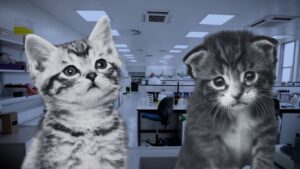Curiosity really is killing cats
Many Australians are surprised to learn that cats are being used in Australian laboratories. However, approximately 2,500 cats are used per year for veterinary and biomedical research.
Some of the experiments which use cats are categorised in the ‘major physiological challenge’ category. Experiments in this category require the animal(s) to remain conscious for some or all of the procedure and involve interference with the animal’s physiological or psychological processes. The challenge causes a moderate or large degree of pain/distress, which is not quickly or effectively alleviated. Examples include causing major infection; artificially inducing disease without pain alleviation; and isolation or environmental deprivation for extended periods.
All over Australia, cats are also being used in what is called ‘basic research’ – this is research that is conducted in an attempt to understand basic phenomena, or out of ‘scientific curiosity’, without seeking specific applications of the research.
Irrespective of the type of research being conducted, cats are not laboratory tools for researchers. And yet we continue to see thousands of cats used in experiments in Australia every year.
Are experiments on cats reliable for medical research?
There are major anatomical, genetic, dietetic, environmental, toxic, and immune differences between animals – including cats – and humans (1) making them inappropriate for use in studying human disease. Many studies and systematic reviews show that there is discordance between animal and human studies, and that animal ‘models’ fail to mimic clinical disease adequately (2,3).
A study by Rattay et al (4) compared the anatomical auditory nerve differences between the cats and humans in order to determine if results from the cat ear are really transferrable to humans. The study found a number of differences, as expected, and stated.
“Shorter total lengths of SGNs in cat, thinner processes, smaller cell bodies and fundamental differences in myelination are obvious reasons not to rely on a cat model when signalling in human auditory nerve is discussed as these differences between the species may lead to important differences in auditory nerve function.”
Given this, we should be investing in advanced human biology-based methods of research, in order for results to be directly relevant to human health outcomes.
It is now time to end the use of cats in research laboratories and instead, focus on research that is human-relevant.
References
(1) Pound P, Ebrahim S, Sandercock P, Bracken MB, Roberts I; on behalf of the Reviewing Animal Trials Systematically Group 2004. ‘Where is the evidence that animal research benefits humans?’, BMJ, 328, 514-7.
(2) Perel P, Roberts I, Sena E, Wheble P, Briscoe C, Sandercock P, et al. 2007. ‘Comparison of treatment effects between animal experiments and clinical trials: systemic review’, BMJ, 334:197.
(3) Van der Worp H, Howells DV, Sena ES, Porritt MJ, Rewell S, O”Collins V, et al. 2010. ‘Can animal models of disease reliably inform human studies?’, PLoS Med.
(4) Rattay, F., Potrusil, T., Wenger, C., Wise, A. K., Glueckert, R., & Schrott-Fischer, A. (2013). Impact of morphometry, myelinization and synaptic current strength on spike conduction in human and cat spiral ganglion neurons. PloS one, 8(11), e79256. https://doi.org/10.1371/journal.pone.0079256
Stay informed
Sign up to our newsletter for all the latest news and SMS campaign alerts.
"*" indicates required fields
© 2025 Animal-Free Science Advocacy | ABN 17 208 630 818 | Privacy Statement | Terms & Conditions In the spirit of reconciliation, we acknowledge the Traditional Custodians of country throughout Australia and their enduring connections to land, sea and community. We pay respect to their Elders past and present.

